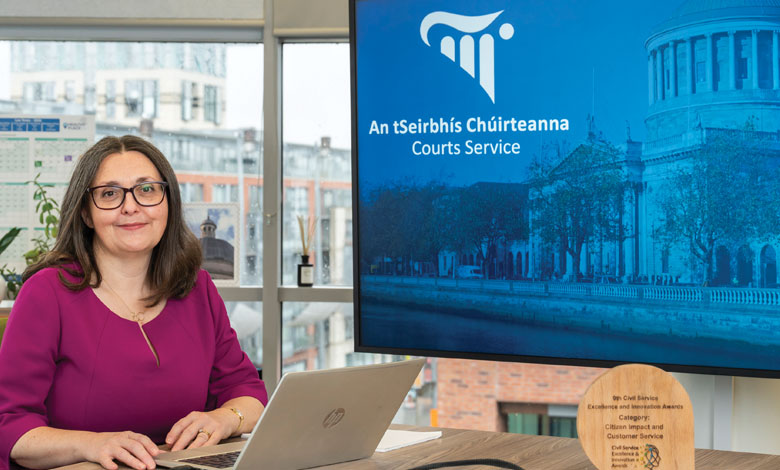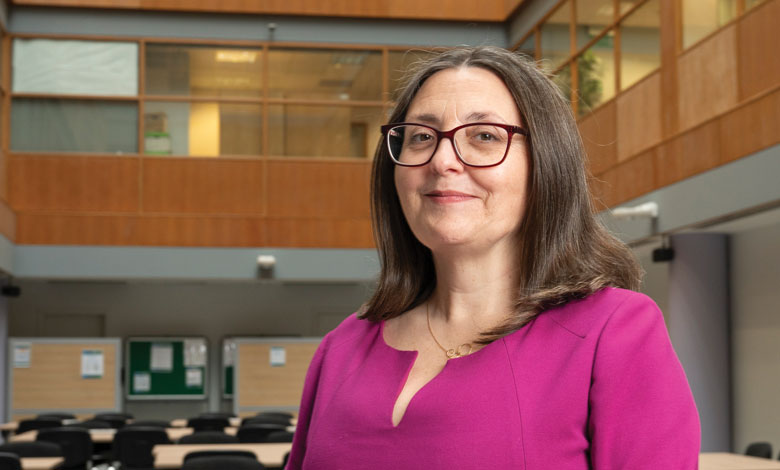Putting court users first

At the halfway point of the Courts Service’s 10-year modernisation journey, Chief Executive Angela Denning discusses successes to date and ongoing work to provide enhanced service delivery on behalf of staff, court users, and legal practitioners.
In 2018, the Courts Service participated in an organisational capability review to scrutinise the Service’s structures, capacity, and approaches to strategy, leadership delivery, and organisational capability.
In this context, Denning was cognisant of the challenges facing the Courts Service when she was appointed Chief Executive the following year.
“I knew what challenges were facing the organisation and I knew what the solutions were,” she says, emphasising that she could not account for some of the subsequent complexities, not least the Covid-19 pandemic, the Judicial Planning Working Group Report, and the OECD’s Modernising Staffing and Court Management Practices in Ireland report.
“There are many dynamics at play, but we must be flexible and agile enough to deal with the unexpected,” she observes.
While the Courts Service manages an estate comprising 101 court venues, with court sitting every day across the State’s five court jurisdictions – District Court, Circuit Court, High Court, Court of Appeal, and Supreme Court – its remit is not simply confined to the courtroom. Rather, it provides a range of services essential to the operation of the courts system.
“We are at the centre of the justice sector and, as such, there is significant connectivity between us and other justice agencies. For instance, we invest money on behalf of minors and wards of court, and we also work closely with to An Garda Síochána and the Irish Prison Service,” the Chief Executive explains.
“At the same time, we have a statutory obligation to provide information on the courts system to the public. Court users must understand what the courts system does, how it works for them, its limitations, and how they can use the system to vindicate their rights.”
Benefits to the justice sector
Having begun in 2019, under Denning’s stewardship, the Courts Service is now at the midway point of a 10-year journey of modernisation designed to improving access to justice, including through digital transformation.
Denning remains driven by the opportunities being unlocked for the wider justice sector “to undertake more work digitally”.
For instance, the Courts Service has continued to expand its portfolio of technology-enabled courtrooms, installing video technology in 165 courtrooms, supporting the digital administration of the courts while also enhancing collaboration with other justice agencies.
“In a post-pandemic context” Denning explains, “The use of video technology has enabled the Irish Prison Service to reduce its total number of prisoner transports by a total of around 21,000 each year. Indeed, in some district courts, we are approaching 100 per cent of prisoners produced by way of video. Equally the NGOs and representative organisations, who work with vulnerable witnesses and court users, have confirmed that the option to attend court remotely is helping to reduce the stress and anxiety among their users.
“The increased prevalence of technology-enabled courtrooms is also supporting An Garda Síochána’s digitalisation initiatives – including, for example, the introduction of body worn cameras for frontline gardaí – enabling evidence to be digitally displayed in court. A really good example of the wider benefits of Courts Service modernisation.”
“The increased prevalence of technology-enabled courtrooms is also supporting An Garda Síochána’s digitalisation initiatives – including, for example, the introduction of body worn cameras for frontline gardaí – enabling evidence to be digitally displayed in court. A really good example of the wider benefits of Courts Service modernisation.”
Angela Denning, CEO, the Courts Service
Simultaneously, the Courts Service has undertaken a significant overhaul of Wi-Fi infrastructure, dramatically improving connectivity nationwide and enabling practitioners to interact digitally.
Quality data
In the area of data and data sharing, the Courts Service has established a dedicated unit to improve data management, while also introducing several new data policies to govern how it is stored, archived, accessed, and destroyed.
“Increasingly, as our data improve and as we roll out the new systems, we are beginning to see that the possibilities for their use in the future, particularly around policymaking,” Denning remarks.
“Data transfer saves time and administrative effort across the justice sector. Previously, the ability to access good quality and reliable data to inform future policymaking was absent across the justice sector.
“Now, however, the Courts Service has improved its data, as has An Garda Síochána, the Irish Prison Service, and other justice agencies. Together, the data and data sharing will continue to improve and unlock benefits across the entire sector.”
In a Courts Service context, the response to the Judicial Planning Working Group’s Report’s recommendations has produced a step change in the availability of quality data through the introduction of several dashboards and quarterly statistical reports by the new data unit.
Discussing this “unexpected but very welcome benefit” of the Judicial Planning Working Group’s Report, Denning emphasises: “The ability to determine a better understanding of trends is significant. Now, we can project how trends are materialising in particular areas of work, and work with the Court Presidents to respond to those before they become a challenge.”
Replacing 150 disparate systems
Another major component of the modernisation programme benefitting justice sector users will be the end-to-end processing of case work through the introduction of a new unified case management system (UCMS).
Previously, the Courts Service’s technology ecosystem has been highly fragmented. “There was no interoperability,” Denning reflects, adding: “In the High Court, for example, only a total of 56 people could be logged in each day versus almost 100 members of staff.
Already underpinning assisted decision-making capacity (ADMC) cases, probate, and the tracking of High Court cases and Circuit Court family law cases, the UCMS is replacing around 150 legacy IT systems – one jurisdiction at a time – with a single, standardised system.
Ultimately, the UCMS provides the back-office technology for Courts Service staff which will be expanded for case tracking across all five jurisdictions in the courts system. One platform with three interfaces one for staff, one for legal practitioners via a portal, and the judiciary via UCMS Judiciary.
“The unified case management system with its three interfaces is the gamechanger for the Courts Service; ensuring data interoperability between systems. When we introduced the family law system in 2024, for instance, it replaced 27 individual databases. Now we can get search results quicker, automate list preparation and we can digitally populate case information into the court orders. Previously, all of this was being completed manually,” the CEO describes.
Continuing in phased and iterative rollout, UCMS assists staff managing cases by improving digital record-keeping through bulk actions, pre-populated order templates, validation for data entry, and automatically generated statistics and reports.
“When I last spoke with eolas Magazine in summer 2024, I explained that the Courts Service was launching the High Court system. We have one interface well underway. On the staff side, we have gone live with the High Court system, and assisted decision-making is up and running. We have introduced the internal case management system for Circuit Court family law cases, and for Probate,” Denning notes.
Turning to ongoing work to expand the UCMS, she emphasises that in terms of the external Portal, “a family law case was lodged in Athlone Law Centre to the Tullamore Law Centre” and “we are going live in the Dublin office this month [May 2025]”. There is also work underway on the judicial portal. This incremental approach allows us to improve based on user feedback as we develop the platform.
“Our ambition is to migrate all our staff onto the new system by the end of 2026, while the portal will be live for some areas of work for practitioners and the judiciary as well,” the Chief Executive outlines.
Court users
Amid the ongoing modernisation journey, Denning describes the Courts Service’s objective of supporting court users as “the whole ethos underpinning our programme of work”.
“We talk to court users, we listen to their pain points, we understand them, and then we design something that matches their needs,” she explains. “We then return to users and seek additional feedback to refine and iterate our system. For example, we have implemented an appointment booking system to enable court users to attend a court office at a time that suits them, simultaneously reducing waiting times.”
Furthermore, in response to court user feedback indicating that the language used on the Courts Service website was inaccessible for many, “we have pivoted to providing plain language information about family law, probate, repossessions and debt claims and sought to simplify our forms on our improved website”.
Overhauling the accessibility of information on the Courts Service website has, the CEO asserts, “made a material difference in assisting people to respond to basic questions on the court process”.
“The feedback we are receiving from our users, particularly in the NGO space, is that the availability of plain language information in the area of family law has been of significant assistance. People who can better understand the process they are entering, what is required of them, and what assistance is available from the State, can make more informed decisions for them and their families,” she says.
Trauma informed practice training
Turning to the rollout of trauma informed practice training tailored to the needs of the Courts Service and court users, Denning is reflective. “At every interface along a person’s journey through the courts system, we can better understand the court users and meet the high standard of service delivery we have set for ourselves. Nobody comes to court because they want to. Rather, something has gone wrong in their lives, often resulting in trauma,” she says.
“Today, we have over 700 members of staff – including all of the management team – who have participated in trauma informed practice training. This has been transformational. It has helped us to better understand the people who are using the courts.
“At the end of the day, the Courts Service exists to help people navigate the Irish courts system in an optimal way. Anything we can do to helps victims, vulnerable witnesses, children, families, and even the people who are accused of crimes through the system is a positive.”
Trauma informed practice training has also shaped the Courts Service’s approach to court forms. “We recognised that by asking people to tell their story again, in order to help them fill out a court form replete with very complex legal language, was retraumatising. Designing with users for users, we have redeveloped our District Court Family Forms which were trialled in three pilot offices across the country. 60 per cent of users were able to complete the forms independently, in their space,” the CEO says.
“Taking a service design approach, means we’ve been considering every step of a person’s journey through the courts system and how we can make it better, one step at a time.”
Capital estate
Another significant part of the Courts Service’s remit is ensuring that its existing capital estate is accessible and fit for purpose in supporting the administration of justice.
While progress has been made on improving the overall estate, the Courts Service acknowledges that further action is required to ensure that all facilities meet modern standards.
In September 2021, Denning appeared before the Oireachtas Joint Committee on Justice to discuss the Courts Service’s estate of 103 courthouse venues and 251 courtrooms, most of which are protected structures with an average age of over 160 years. This presents a significant challenge.
Recalling this appearance, the CEO acknowledges the challenging condition of “our ageing capital estate” and the fact that “many court facilities which do not meet specifications for accessibility or usability”.
In its corporate strategy for 2024-2027, the Courts Service outlines four priority actions to “provide buildings that are modern, fit for purpose, safe and accessible and support the new ways in which we will conduct business”.
While emphasising that the challenges in relation to court facilities across the State is ongoing, Denning highlights the construction of new family law courts at the Hammond Lane site in Dublin – due for completion by the end of 2028 – as one such action that will make a tangible difference.
Vision
Reiterating that the Court Service’s vision is to position the court user at the heart of its services, Denning insists that her organisation will continue to improve access to justice, reduce inefficiencies within the courts system, and optimise digitalisation for improved service delivery.
“We will continue to roll out the UCMS across all areas of work and across all five court jurisdictions,” she outlines, adding: “Once complete, the Courts Service website will be an exemplar among public services. I am very pleased that the portions of the website that we have updated are already starting to record better engagement rates with users online. This type of recognition encourages us that we are making progress against our objectives.”
Asked what mission success will look like for the Courts Service, Denning’s response emphasises continuous improvement. “We must continue to interact with our users, to iterate and to improve the High Court system, for example, that was rolled out in October 2023. Already, we have had 30 updates to that system. While this process is labour intensive, it works and is agile.
“Only by going out and engaging with people can we determine whether we are doing things well or not. I would like to see all our data dashboards trending along this upward trajectory.”
Summarising, the Courts Service CEO expresses gratitude for the support that the modernisation programme has attracted from government. “We can see the continued improvements across the courts system in terms of technology, data, user feedback, and putting the court user first in everything we do. Government has supported us the whole way through this modernisation journey and as long as this support is sustained, we will continue to deliver,” she concludes.








